Survey: 1 in 4 Homeowners Feel Financially Unprepared for Costs of Extreme Weather Events

As extreme weather events intensify nationwide, a significant number of homeowners are left financially vulnerable and ill-prepared for the substantial costs associated with these severe storms.
In fact, more than 1 in 4 (26 percent) U.S. homeowners say they are unprepared for the potential costs associated with extreme weather events in their area according to Bankrate’s 2024 Extreme Weather Survey. More specifically, 14 percent say they are somewhat unprepared and 12 percent say they are very unprepared.
Proactive measures and financial readiness are essential for homeowners to navigate the aftermath of extreme weather with confidence and resilience. While 39 percent of homeowners say they have reviewed their auto and/or home insurance policies to ensure they had proper coverage, only 9 percent say they have invested in weather-proofing strategies within the last five years.
Auto and homeowners insurance rates have been surging for a variety of reasons, including higher losses, climate change and elevated costs for labor and materials — this is making cost of living pressures even worse. There may be a temptation to skimp on coverage, but that could leave you unprepared if disaster strikes.— Ted Rossman, Senior Industry Analyst
- Most homeowners feel prepared for extreme weather. 59% of U.S. homeowners say they are financially prepared for the potential costs associated with extreme weather events in their area — such as hurricanes, tornados, wildfires, flooding, heavy snow, severe storms, extreme heat or drought — including 42% who say they are somewhat prepared and 17% who say they are very prepared.
- Southern homeowners are more likely to incur debt when paying their deductible. 20% of U.S. Southern homeowners say that they would be unable to pay their deductible without going into debt if their home sustained major damage from a severe weather event, the highest percentage of all other regions.
- Low-income households may struggle to cover potential costs associated with extreme weather. Only 48% of U.S. homeowners earning under $50K per year say they are financially prepared for the potential cost associated with extreme weather events in their area compared to 71% of homeowners earning $100K or more.
- Not all homeowners rely on insurance. 7 percent of U.S. homeowners say they do not have homeowners insurance, and 10 percent say they do not expect to be financially impacted by extreme weather events in their area.
2 out of 5 homeowners have not done anything within the last five years to protect their property against extreme weather damage
The majority of U.S. homeowners (57 percent) have taken action to mitigate the financial impact of damage from extreme weather, with 39 percent saying they reviewed their auto and/or home insurance policies within the last five years to ensure they had proper coverage.
Understanding what perils your auto and homeowners insurance covers, what it excludes and your deductibles is an essential step toward comprehending if additional measures are needed.
With some home insurance carriers withdrawing or limiting coverage in some high-risk regions of the country, coverage needs can change over time. The same goes for home preparation needs as extreme weather shifts and intensifies. In the last five years, 9 percent of homeowners invested in weather-proofing strategies, and 7 percent of homeowners moved to an area at lower risk from extreme weather.
Below is a regional breakdown of the percentage of homeowners that increased their existing insurance or purchased additional coverage. Northeastern homeowners were most likely to invest in these measures.
- Northeastern homeowners: 17 percent
- Southern homeowners: 13 percent
- Midwestern homeowners: 8 percent
- Western homeowners: 14 percent
With wildfires and hurricane losses more prevalent in certain areas, it makes sense why twice as many Southern (10 percent) and Western (12 percent) homeowners invested in weather-proofing strategies in the past five years compared to Midwestern and Northeastern homeowners, at 5 and 6 percent respectively.
In total, 29 percent of U.S. homeowners made a change to their insurance policy within the last five years as a precautionary measure.
- Lowered their auto or home insurance deductibles: 8 percent
- Changed insurance carriers: 15 percent
- Increased their existing insurance coverage or purchased additional coverage: 13 percent
Note: Respondents to our Extreme Weather Survey could select more than one option.
Bankrate tip
Even if you don't change your insurance policy, frequently comparing rates between carriers can alert you when your current carrier is no longer competitive.
Compare home insurance quotes“I’d like to see a lot more people shopping around for coverage,” says Rossman. “Too often, insurance is a set-it-and-forget-it kind of thing. Costs can creep up over time. Use the competitive market to your advantage and shop around at least every few years. Aim to include at least three different carriers in your search.”
Preventative actions taken against damage from extreme weather events: Renters vs. homeowners
Renters face the same extreme weather events as homeowners, but generally have less financial risk because they don’t own their homes. In almost every category, renters were less likely to have taken action than homeowners to limit their risk of loss from extreme weather. However, there are a few similarities.
The same percentage of renters and homeowners (7 percent) say they moved to an area at lower risk from extreme weather. Additionally, 9 percent of homeowners and 4 percent of renters invested in weather-proofing strategies.
We asked homeowners: Which, if any, of the following have you done in the past 5 years (i.e., since July 2019 to now) as a precaution to protect your property against damage from extreme weather events (e.g., a hurricane, tornado, wildfire, flooding, heavy snow, severe storms, extreme heat, drought, etc.)? Please select all that apply.
To people who rent, we also asked: Which of the following best applies to your main home?
| Renters | Homeowners | |
|---|---|---|
| I reviewed my homeowner and/or auto insurance policy to ensure I have proper coverage | 13% | 39% |
| I lowered my auto and/or home insurance deductible(s) | 6% | 8% |
| I changed insurance carriers | 8% | 15% |
| I increased my existing insurance coverage/purchased additional coverage | 6% | 13% |
| I invested in weather-proofing strategies (e.g., hurricane shutters, upgraded home with fire resistant materials, roof reinforcement, etc.) | 4% | 9% |
| I moved to an area at lower risk from extreme weather | 7% | 7% |
| None of these – I have not done anything to protect against property damage due to extreme weather events | 71% | 43% |
| Net: Made a change to my insurance policy | 16% | 29% |
More than 1 in 4 of homeowners say they are unprepared for the potential costs associated with extreme weather events in their area
59 percent of U.S. homeowners say they are financially prepared for the potential costs associated with extreme weather events in their area, with the majority (42 percent) describing their level of preparedness as somewhat prepared. Only 17 percent of homeowners say they are very prepared.
In contrast, more than 1 in 4 (26 percent) homeowners say they are unprepared for the potential associated costs, including 14 percent who say they are somewhat unprepared and 12 percent who are very unprepared.
“Disaster preparedness isn’t the most fun or urgent task under normal circumstances, but it’s very important,” says Rossman. “If you wait until a storm is bearing down on your area, it’s too late. Take steps to get ready ahead of time, such as building an emergency fund, signing up for sufficient insurance coverage, making necessary home improvements, and gathering needed supplies.”
Midwestern homeowners stand out the most for financial readiness regionally.
66 percent of Midwestern homeowners say they are financially prepared for the potential costs associated with extreme weather events in their area, with 20 percent saying they are very prepared and 46 percent saying they are somewhat prepared — the highest percentage out of any region:
We asked: How would you describe your level of financial preparedness regarding the potential costs associated with extreme weather events in your area (e.g., a hurricane, tornado, wildfire, flooding, heavy snow, severe storms, extreme heat, drought, etc.)?
| Region | Very prepared | Somewhat prepared |
|---|---|---|
| Midwest | 20% | 46% |
| Northeast | 19% | 42% |
| West | 17% | 38% |
| South | 16% | 41% |
In contrast, homeowners in the South and West are slightly more likely to be financially unprepared for the potential costs associated with extreme weather:
We asked: How would you describe your level of financial preparedness regarding the potential costs associated with extreme weather events in your area (e.g., a hurricane, tornado, wildfire, flooding, heavy snow, severe storms, extreme heat, drought, etc.)?
| Region | Very unprepared | Somewhat unprepared |
|---|---|---|
| South | 13% | 16% |
| West | 10% | 18% |
| Northeast | 13% | 13% |
| Midwest | 10% | 10% |
Lower income homeowners are most vulnerable to extreme weather
Only 48 percent of U.S. homeowners earning less than $50,000 per year say they are financially prepared for the potential cost associated with extreme weather events in their area, compared to 71 percent of homeowners earning $100,000 or more annually.
Income level plays a significant role in the financial battle against extreme weather losses. 35 percent of homeowners identify as being unprepared for the potential costs — the most out of all other income brackets — with 20 percent saying they are very unprepared.
We asked: How would you describe your level of financial preparedness regarding the potential costs associated with extreme weather events in your area (e.g., a hurricane, tornado, wildfire, flooding, heavy snow, severe storms, extreme heat, drought, etc.)?
| Household income | Very prepared | Somewhat prepared | Somewhat unprepared | Very unprepared |
|---|---|---|---|---|
| Under $50,000 | 12% | 36% | 16% | 20% |
| $50,000 to $79,999 | 18% | 42% | 15% | 12% |
| $80,000 to $99,999 | 19% | 47% | 16% | 8% |
| $100,000 and over | 24% | 46% | 13% | 5% |
15% of homeowners say they would be unable to pay their deductible without going into debt if their home sustained major damage from a severe weather event
Overall, most U.S. homeowners (65 percent) say they would be able to pay their deductible without going into debt if their home sustained major damage from a severe weather event. Respondents were given credit card debt and a personal loan as debt examples.
In contrast, 15 percent of homeowners say they would be unable to pay their deductible without incurring debt. Additionally, 7 percent of homeowners say they do not have homeowners insurance, and 13 percent say they do not know what their homeowners insurance deductible is.
“The average homeowners insurance deductible is $1,000; it’s $500 for car insurance,” says Rossman. “A Bankrate survey found just 44 percent of Americans could afford to pay for an unexpected $1,000 expense from their savings. Many of those who say they’re adequately prepared may not be truly ready. Setting money aside from every paycheck is the best way to build an emergency fund. It’s your ‘sleep at night’ money and provides a buffer against high-cost credit card debt.”
Geographical location may influence the likelihood of Americans incurring debt due to extreme weather events.
The type and amount of deductible a homeowner must pay in the event of a covered claim depends on their policy and the options available with their carrier and state. Homeowners living along the coast or the Gulf of Mexico will likely have a wind, hurricane or named storm deductible for wind claims plus a standard flat deductible for other claim types.
Wind deductibles can range between 1 and 10 percent of the dwelling coverage. So, for example, a home with $300,000 in dwelling coverage may have a wind deductible between $3,000 and $30,000. Some homeowners may have a separate windstorm or wildfire policy with a different deductible than their home insurance policy. Additionally, flood insurance is usually a standalone insurance product with a separate deductible.
Depending on the type of catastrophic natural disaster, homeowners may be responsible for more than one deductible resulting from the same or concurrent extreme weather events. Insurance coverage, availability, cost and deductible options can depend on how insurance carriers rate the risk of extreme weather damage in your area.
Homeowners in the South are more likely to have a percentage-based wind deductible and carry a flood policy than homeowners in other regions. This could be why Southern homeowners (20 percent) are more likely to say that they would be unable to pay their deductible without going into debt if their home sustains major damage from a severe weather event, compared to only 10 percent of Midwestern homeowners.
With home insurance rates increasing around the country, nearly 1 in 5 homeowners who make less than $50k (15%) say they do not have homeowners insurance.
Regionally, 8 percent of homeowners in the South say they do not have home insurance, which is fairly close to homeowners in other regions — 7 percent of Western and Midwestern homeowners, and 5 percent for Northeastern homeowners.
However, when we analyze the data by household income, the number of uninsured homeowners increased more (between 11 and 13 percent) for those earning less than $50K per year than any other income bracket.
Homeowners without homeowners insurance by household income:
- Under $50,000: 15 percent
- $50,000 to $79,999: 4 percent
- $80,000 to $99,999: 2 percent
- $100,000 and over: 3 percent
Bankrate’s analysis of the July 2024 CPI data shows that the price of building materials is still 22.1 percent higher than pre-pandemic costs. With inflation impacting rebuilding costs so dramatically over a short period, some homeowners may find themselves underinsured. Checking with your agent to ensure your coverage will be sufficient if your home suffers severe damage can help you avoid a significant coverage gap.
Household income also shows a clear distinction in financial preparedness between homeowners earning below and above $79,999.
More than twice as many homeowners with a household income between $50,000 and $79,999 (18 percent) say they would be unable to pay their deductible without going into debt compared to homeowners with household incomes of $80,000 to $99,999 (8 percent) and $100k or more (8 percent).
Additionally, almost three times as many homeowners with a household income under $50,000 a year (21 percent) say they would be unable to pay their deductible without going into debt if their home sustained major damage from a severe weather event, compared to homeowners earning $80k or more (8 percent).
3 strategies for mitigating financial loss from extreme weather
1. Put money aside for a rainy day
Bankrate’s 2024 Annual Emergency Savings Report found that 27 percent of U.S. adults have no emergency savings or money that is readily available in either a checking account, savings account or money market. Beyond your insurance deductible, extreme weather may cause you to evacuate your home, lose income or buy building and repair materials as a stopgap while your claim is being processed. There are several expenses related to extreme weather events that having an emergency savings account makes easier to navigate. Even if you start small and save a few dollars a week, every penny counts when disaster strikes.
2. Beware of coverage gaps
With extreme weather impacting climate across the country, homeowners may discover that they have coverage gaps in their insurance policy that didn’t exist before. If you are unsure if extreme weather impacts where you live, using online climate risk tools like ClimateCheck and FirstStreet can show how extreme weather will change over the next 30 years based on your address. Consider asking your insurance agent about additional endorsements or stand-alone policies to avoid potentially having to cover these losses out of pocket. Even if you haven’t budgeted for additional types of coverage previously, comparison shopping can help you with future financial planning.
3. Use insurance as a backup plan, not the only plan
Frequent home insurance claims can drive up the cost of your premium and put your policy in jeopardy of being nonrenewed. Paying for small damages out of pocket and utilizing your insurance for emergencies is one way to keep your home insurance costs lower. Another option is to invest in weather mitigation to reduce the risk and amount of extreme weather damage. From budget-friendly options, like cinder blocks to lift your major appliances off the ground before a flood, to significant changes, like a new roof, implementing any mitigation strategies can bring you closer to long-term financial security.
You may also like

How to save on homeowners insurance premiums in 2025

Best high-risk homeowners insurance companies




